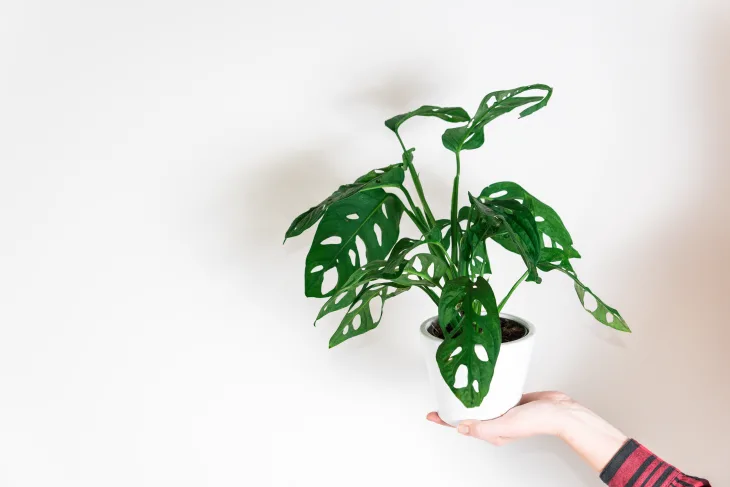You’ve definitely heard of Monstera deliciosa—the massive, sculptural houseplant right out of Mad Men that now features in around 75% of all design bloggers’ Instagram pictures. It’s loved for being both easy to grow and for appearing excellent next to a semi sofa. But have you met Monstera adansonii, its descendant? Despite its delicate delicacy, nurturing this lacy shrub is rather simple.

Monsteras are known as Swiss cheese vines or plants because of their lacy holes and notches in their leaves, and adansonii is possibly the silliest of them all. Its leaves are much more porous and sensitive than those of deliciosa, as well as the plant being smaller in size. Although all Monsteras are vines, adansonii has a trailing aspect that makes it ideal for suspending vases or training around a room.
If you’re on the lookout for a low-maintenance, one-of-a-kind vining houseplant that’s a bit hard to come by, you’re in luck! Look no further than the Swiss Cheese Vine, named for its perforated, arrow-shaped leaves with oblong holes. This fast-growing plant loves to climb and will bring a unique touch to any room with minimal upkeep required. Caring for this stylish plant is a breeze – simply place it in a spot with bright indirect light (although it can handle lower light too) and water the soil only when it’s almost completely dry. When this type of fast-growing vine is actively growing, make sure to give it some fertilizer.
How to Take Care of Monstera Adansonii
Light
Indoor plants are adaptable to low light, but to encourage faster growth and larger leaves, it’s best to provide medium to bright indirect light. Place them closer to a north or east-facing window for access to more sunlight, or keep them out of direct light in a south or west-facing window. Knowing the best location for your plants to thrive is key!
Water
When it comes to watering, Monstera plants thrive when they’re given a good soak after the soil has almost completely dried out. During the warmer months when they’re growing, water more frequently, and reduce watering during the winter months, allowing the soil to almost completely dry out between waterings. It’s important to note that Monstera adansonii should be watered more often than larger-leaved varieties like deliciosa due to its thinner leaves that hold less moisture.
Soil
For the best soil for Monstera adansonii, use nutrient-rich, loose, and well-draining potting soil. Most bagged potting soil mixtures are acceptable, but avoid those that contain moisture-retaining crystals. Let the soil dry out before giving it a thorough soak.
Temperature for Monstera adansonii
Monstera plants can thrive in most household temperatures, but ideally they prefer temperatures between 65-85℉. While they can withstand temperatures as low as 50℉, growth may slow down when exposed to colder temperatures.
Humidity For Monstera adansonii
To ensure healthy growth, all types of Monstera plants benefit from higher humidity levels. One way to increase humidity is to use a humidifier in the room. You can also fill trays with pebbles and water, which helps increase humidity around the plants immediately, or group indoor plants closer together. Learning how to boost the humidity around your plants is key!
Rate of growth
To promote growth, these houseplants should be fertilized during their active growing season. Use a ¼-diluted fish emulsion with iron or ¼-diluted complete liquid fertilizer twice a month. Another option is to top-dress your plants with compost, such as worm castings, in the spring. This slowly releases nutrients to the roots throughout the growing season.
Once established, Monstera adansonii plants are fast growers and can reach heights of 12+ feet or more indoors when given the right conditions.
How to Propagate Monstera adansonii
Growing baby Monstera adansonii from your current plant is a simple process. First, snip off a section of vine that includes at least two nodes, which are the knobby bits where the leaves form. Then, place the vine in a glass of water until roots begin to form. Once the roots have formed, plant the cutting in soil. With this method, you can easily propagate a new plant to give to a friend or trade at a plant swap.
Monstera adansonii Swiss Cheese Plants: Common Problems
The Swiss cheese plant generally does not have any significant issues when grown under favorable conditions. However, if the plant’s environmental needs are not met indoors, it may be prone to some common problems.
Leaves turning yellow
If the leaves of the plant are turning yellow, it is likely due to overwatering. To avoid this, ensure that the plant is not sitting in waterlogged soil and let the soil dry out a little between waterings.
A blackened leaf
Black marks on the leaves may indicate leaf burn caused by direct sunlight. Monitor your plant throughout the day to ensure that it is not exposed to direct sunlight for extended periods, especially during the strong afternoon sun. Take measures to protect the plant from direct sunlight if needed.


